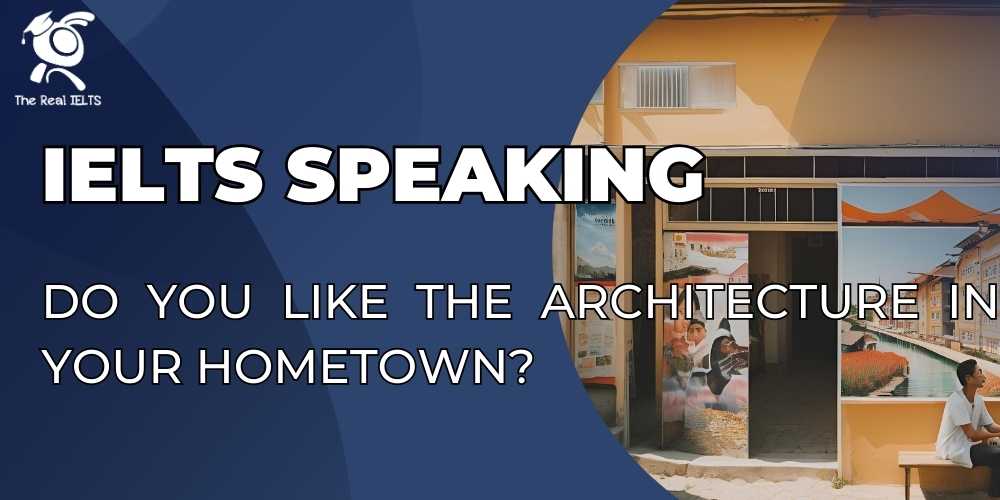Bài viết “Do you like the architecture in your hometown? IELTS Speaking Part 1” cung cấp hướng dẫn chi tiết để trả lời câu hỏi về kiến trúc quê hương trong phần thi IELTS Speaking. Bạn sẽ học cách mô tả đặc điểm kiến trúc, cảm xúc cá nhân, và so sánh với các nơi khác. Bài viết còn gợi ý từ vựng, cấu trúc câu, và mẹo để đạt điểm cao. Phù hợp cho thí sinh muốn cải thiện kỹ năng nói và tự tin hơn trong kỳ thi.
Đọc thêm các bài luyện thi IELTS khác.
Đọc thêm câu hỏi khác tại: IELTS Speaking Part 1: Introduction and Interview chủ đề Your hometown.
Đọc thêm IELTS Speaking: Are there any traditional festivals in your hometown?
Câu trả lời IELTS Speaking: Do you like the architecture in your hometown?
Ví dụ 1:
Introduction:
My hometown is Hanoi, the capital city of Vietnam, located in the northern part of the country. It’s a place that holds deep significance for me because it’s where I grew up and where my family has lived for generations. Hanoi is not only the political and cultural heart of Vietnam but also a city with a rich architectural heritage that reflects its long and diverse history.
Geographical Description:
Hanoi is a city of contrasts, blending natural beauty with urban development. It’s surrounded by rivers, such as the Red River, and dotted with lakes, like the iconic Hoan Kiem Lake, which lies at the center of the city. The landscape is relatively flat, but the architecture adds a unique vertical dimension to the cityscape.
Cultural Aspects:
The architecture in Hanoi is a testament to its cultural diversity and historical layers. You can see influences from Chinese, French, and Soviet architecture, all of which have left their mark on the city. For example, the Old Quarter is famous for its narrow streets and traditional Vietnamese tube houses, while the French Quarter boasts grand colonial buildings like the Hanoi Opera House. Festivals like Tet (Lunar New Year) often highlight the beauty of these architectural styles, with decorations adorning the streets and buildings.
Historical Background:
Hanoi has over a thousand years of history, and its architecture tells the story of its past. The Temple of Literature, built in 1070, is a prime example of traditional Vietnamese architecture and is dedicated to Confucius. The Ho Chi Minh Mausoleum, on the other hand, reflects Soviet-style architecture and is a symbol of Vietnam’s modern history. These landmarks are not just tourist attractions but also reminders of the city’s resilience and evolution.
Economic Activities:
The architecture in Hanoi also reflects its economic activities. The Old Quarter, for instance, was historically a hub for trade, and its buildings were designed to accommodate both living and working spaces. Today, modern skyscrapers and commercial centers, like the Lotte Center, symbolize Hanoi’s growing economy and its role as a business hub in Southeast Asia.
Personal Connection:
For me, the architecture in Hanoi is more than just buildings; it’s a part of my identity. I have fond memories of walking through the Old Quarter with my family, admiring the blend of old and new. I also remember visiting the Temple of Literature as a child and feeling a sense of pride in my heritage. The architecture in Hanoi is special to me because it connects me to my roots and reminds me of the city’s enduring spirit.
Conclusion:
In summary, the architecture in Hanoi is a beautiful mix of tradition and modernity, reflecting the city’s rich history and cultural diversity. From the ancient temples to the colonial buildings and modern skyscrapers, each structure tells a story. What I love most about Hanoi’s architecture is how it makes me feel at home, no matter where I am in the world. It’s a constant reminder of where I come from and what makes my hometown unique.
Ví dụ 2:
Introduction:
My hometown is Da Nang, a vibrant coastal city in central Vietnam. It’s a place that holds a special place in my heart because of its stunning natural beauty and its unique blend of traditional and modern architecture. Da Nang is not only a hub for tourism but also a city that has managed to preserve its cultural heritage while embracing modernity.
Geographical Description:
Da Nang is blessed with a breathtaking geographical landscape. It’s nestled between the Truong Son Mountains and the South China Sea, offering a mix of mountains, rivers, and pristine beaches. The Han River flows through the city, dividing it into two parts, and the iconic Dragon Bridge is a symbol of Da Nang’s architectural innovation.
Cultural Aspects:
The architecture in Da Nang reflects its cultural diversity and history. You can find traditional Vietnamese pagodas, such as the Linh Ung Pagoda on Son Tra Peninsula, alongside modern structures like the Da Nang Museum of Fine Arts. The city also hosts unique festivals, such as the Da Nang International Fireworks Festival, which lights up the sky and showcases the beauty of its riverside architecture.
Historical Background:
Da Nang has a rich historical background, and its architecture tells the story of its past. The Marble Mountains, for example, are not only a natural wonder but also home to ancient Buddhist temples and caves. The city’s colonial history is evident in buildings like the Da Nang Cathedral, which features French Gothic architecture. These landmarks are a testament to Da Nang’s historical significance and cultural evolution.
Economic Activities:
The architecture in Da Nang is closely tied to its economic activities. As a major port city, Da Nang has a mix of industrial and commercial buildings. The city’s skyline is rapidly changing, with new developments like the Da Nang Administrative Center and luxury resorts along My Khe Beach. These structures reflect Da Nang’s growing economy and its role as a key player in Vietnam’s tourism and trade industries.
Personal Connection:
For me, the architecture in Da Nang is deeply personal. I have countless memories of walking along the Han River at night, watching the Dragon Bridge breathe fire and water. I also remember visiting the Marble Mountains with my friends and being in awe of the ancient temples hidden within the caves. The architecture in Da Nang is special to me because it’s a constant reminder of my childhood and the beauty of my hometown.
Conclusion:
In conclusion, the architecture in Da Nang is a perfect blend of tradition and modernity, reflecting the city’s rich history and dynamic growth. From the ancient pagodas to the futuristic bridges, each structure tells a story. What I love most about Da Nang’s architecture is how it captures the spirit of the city—a place that honors its past while looking toward the future. It’s a source of pride and a testament to why I love my hometown so much.
Introduction:
My hometown is Hue, a city in central Vietnam known for its imperial history and cultural heritage. It’s a place that holds immense significance for me because it’s where I was born and where my family has lived for generations. Hue is often referred to as the “City of Temples” due to its abundance of historical and religious architecture.
Geographical Description:
Hue is located along the Perfume River, which adds to its serene and picturesque landscape. The city is surrounded by lush green hills and is close to the coast, making it a place of natural beauty. The river itself is a central feature of the city, and many of its architectural landmarks are built along its banks.
Cultural Aspects:
The architecture in Hue is deeply rooted in its cultural traditions. The city was the imperial capital of Vietnam, and the Hue Citadel, with its Forbidden Purple City, is a prime example of traditional Vietnamese royal architecture. Hue is also known for its ancient pagodas, such as the Thien Mu Pagoda, which is a symbol of the city. The annual Hue Festival celebrates this rich cultural heritage, with traditional performances and events held in these historic sites.
Historical Background:
Hue’s architecture is a reflection of its historical significance. The Nguyen Dynasty, which ruled Vietnam from the early 19th to the mid-20th century, left behind a legacy of stunning palaces, tombs, and temples. The tombs of the Nguyen emperors, such as the Tomb of Khai Dinh and the Tomb of Tu Duc, are architectural masterpieces that attract visitors from around the world. These sites are not just tourist attractions but also reminders of Hue’s glorious past.
Economic Activities:
The architecture in Hue plays a significant role in its economy, particularly through tourism. The city’s historical sites are major attractions, drawing both domestic and international visitors. Additionally, Hue’s traditional craft villages, such as those producing conical hats and incense, are often housed in charming old buildings that add to the city’s architectural charm.
Personal Connection:
For me, the architecture in Hue is a source of pride and nostalgia. I have fond memories of visiting the Hue Citadel with my grandparents, who would tell me stories about the Nguyen emperors. I also remember taking boat rides on the Perfume River and admiring the Thien Mu Pagoda from afar. The architecture in Hue is special to me because it connects me to my heritage and reminds me of the city’s timeless beauty.
Conclusion:
In summary, the architecture in Hue is a testament to its imperial history and cultural richness. From the grandeur of the Hue Citadel to the tranquility of its pagodas, each structure tells a story. What I love most about Hue’s architecture is how it preserves the city’s legacy and makes me feel connected to my roots. It’s a constant reminder of why I’m so proud to call Hue my hometown.















